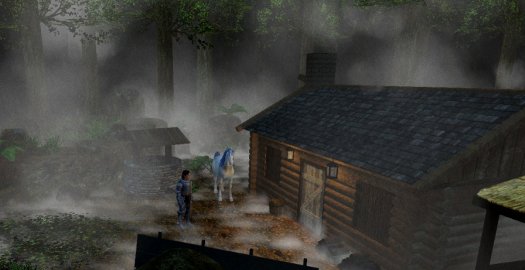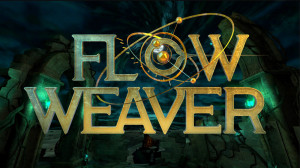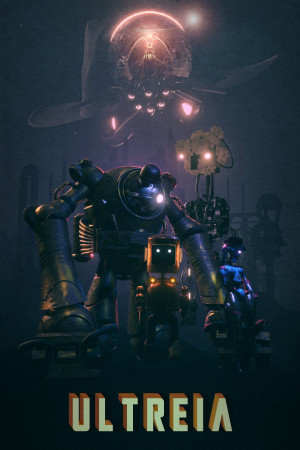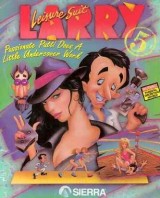Review for Poltergeist Treasure

After an uneven start with Unicorn Dungeon, Stand Off Software continued the tale of Sir Typhil of Creulor with a second installment, Poltergeist Treasure. This time around, the point-and-click portion of the fantasy adventure has been bulked up and takes a turn for the spooky as the armour-clad knight visits a haunted forest, though there’s still plenty of humour and a pair of endearing characters who will go on to become series regulars are first introduced here. Gone is the roguelike gameplay element from the previous title but in its place is a new stealth focus, which unfortunately carries the usual curse of stealth sequences in adventure games: that is, it’s not very good.
At the end of Unicorn Dungeon, Sir Typhil stepped through a magical portal with his newly acquired unicorn on their joint journey back to Artovya, where Typhil hopes to be crowned the new king. As Poltergeist Treasure opens, things haven’t gone quite to plan as the pair emerge from the portal into a night-enshrouded forest blanketed by drifting fog. Immediately it's a very arresting visual, and indeed this second stage in Sir Typhil's tale is far more atmospheric than the first, with a spooky manor, a freshly dug grave, and a dark cottage with a creepy man lurking in the shadows.
Musically the game has shifted to support the darker look, with synth loops leaning towards strings and piano to provide a spookier atmosphere. It’s a mild eeriness; not so tense that you expect some ghost or goblin to jump out of a cupboard at every turn, but it does add to the mood. Sound effects are also suitably used, such as the cry of a lone wolf when the game opens on a shot of the moon, or the clank of Typhil’s armor as he moves along.
As Typhil begins to explore the unnamed forest, he quickly discovers that there’s no way out as he’s looped back to parts of the forest he’s already visited. It’s clear that some manner of sorcery is at work, and that the knight will have to investigate if he hopes to escape and return to his own world. As he does so, he’ll also learn of the dark fates that befell the residents of the nearby manor.
The adventuring side of this installment is much larger than the first game, with the house alone providing more locations to explore, including a kitchen, bedrooms, and a library. These rooms and the surrounding forest aren’t just there for the sake of being there either, as they’re filled with a greater number of puzzles that are more varied than simple inventory item combinations. For instance, one scene contains a lock that must be opened by stepping on pressure plates in the floor in a certain order that can only be determined by carefully interpreting clues scattered elsewhere around the house. There are also many documents to find that will fill in the tragic backstory of what happened in the manor and why it's now deserted.
Along the way, Typhil encounters Lorna and Grimble, two dwarves who have ventured to the region as part of an exciting vacation package they booked in their home of Yorkwen. These two go on to become Typhil’s friends in later games, so it’s fun to see their first meeting, especially as they’re underwhelmed by his claims to be a brave and bold knight. The voices are all well done, with Lorna and Grimble particularly memorable for their cheerfulness and gently condescending attitude towards Typhil.
Unfortunately for all three of them, the land they’re in is haunted by a poltergeist searching for a lost treasure, and it’s this force that prevents anyone who steps beneath the forest’s boughs from leaving. Naturally, being the adventuring sort, Typhil determines to find a way to deal with the spook and break the spell that's keeping them prisoners in these woods.
Controls for guiding Typhil through the adventure portion of Poltergeist Treasure are identical to those of Unicorn Dungeon. The right mouse button is used to toggle between two distinct states: interact and examine. Hotspots are easily identified in the boxy, sparsely decorated rooms, with tooltip labels appearing when moving the mouse over an area of interest. Inventory items are stored in a hidden bar at the top of the screen that is made visible when the mouse is moved there. As with the first game, there are some interesting objects to collect here, such as the golden poop of the unicorn.
The irreverent humour of the first game also carries over into the sequel. Whether it’s a simple housecat that proves to be an insurmountable obstacle for brave Sir Typhil, or Lorna and Grimble being completely unconcerned by the dangers around them as they’re highly trained in dwarf battle arts, there are more than a few situations that provide some chuckles. I stumbled on a particularly memorable but entirely optional one when I attempted to use a torch on a wagon full of hay just to see what would happen.
At four hours in length, and with more locations to explore, this feels like a proper game compared to the more demo-ey series debut. Even so, as with Unicorn Dungeon, most of the play time here is spent in the other genre element stapled uncomfortably onto the point-and-click adventuring. In this case, stealth. In fact, so much time goes into sneaking around that it almost seems like more of a stealth game with adventuring bits added on, rather than the other way around. This is definitely a problem, because the stealth aspect is about as pleasant as having teeth pulled.
The map is divided into two adventuring areas. The main section, where Typhil starts, features the manor and grounds, a small nearby cottage, and most of the forest. The other location is a single outdoor pond scene that needs to be visited multiple times over the course of the story. Between these places, unfortunately, lie zombie-patrolled ruins. To move between the two different regions, Typhil must successfully sneak past the undead creatures and other obstacles in order to stay alive.
Not unlike the dungeon in the previous game, when entering this haunted area the view switches to a 2D top-down perspective. The ruins form a maze of sorts, and you must find a route from one side to the other. The path changes each of the first few times through, becoming more difficult until finally only the hardest course is left to navigate. These passages are gated by magical force fields that injure Typhil if he steps into one. Some of these can be deactivated by lighting nearby fire pits; others are permanent and force Typhil to go a different way when he revisits the ruins. If only those were the only obstacles he had to contend with!
Early on, the ruins contain three adversarial forces. First, there are zombies that follow fixed patrols. A blue cone projected in front of them shows their field of view. If Typhil is caught in one he will be detected, chased down, and hit once by the monster. This depletes some of the knight’s meagre supply of health points, which replenish whenever he exits the ruins. After that the zombie returns to its normal patrol rather than continuing to beat up on poor Sir Typhil. The only way to avoid taking damage is to try to run back to the entrance of the labyrinth, as it’s impossible to lose the zombie or find any hiding place – a glaring omission in a stealth game.
While the zombies' movement patterns are fixed, the way they turn is often jerky, which makes it harder to avoid their field of view than it should be. As well, what they can see tends to be inconsistent. Sometimes a cone will barely graze Typhil but they will be onto him. At other times, when turning their sight can sweep entirely across him and not detect him. Occasionally it seems Typhil can even be spotted through walls if he's standing too close to them. It makes it very difficult to know, even after many, many, many repeated attempts, whether you have Typhil standing in a safe spot or not.
The second threat Typhil faces are gargoyles, which basically operate as security cameras. They maintain permanent positions in the maze with a field-of-view indicator that sweeps back and forth. If Typhil is spotted within this sweep, then the nearest zombie is alerted, who will again chase Typhil until he is caught.
The final enemy Typhil must confront are the ravens. As with the gargoyles, these birds have fixed positions within the ruins. However, their detection method works differently from the others. Instead of having a visual cone, they emit a circular pulse around them. If Typhil is moving when this circle touches him, then the raven will send up an alarm and the zombies will come running. If Typhil is still when this happens, then he is safe. The trouble with these stationary threats is the sheer density of them combined with the zombies patrolling the labyrinth. There are so many adversaries, usually with overlapping fields of view, that finding a safe path is extremely challenging.
I enjoy a good stealth game. In fact, it's one of my favourite genres. I have never played a stealth game as difficult as Poltergeist Treasure. It's so hard that the developer felt obliged to modify it after its initial release by adding the option to remove the gargoyles and ravens if you die ten times in the maze. Even that is punishing, as dying sends you back to the start of the sequence with all of your progress lost, and there is no manual save option for recording your progress within the ruins. (Saving only occurs, as in Unicorn Dungeon, automatically when entering a new scene in the normal adventure section.)
Movement through the ruins is problematic in its own right, as instead of clicking your way through or using keyboard keys to move up, down, left and right, you must awkwardly rotate left or right with the A and D keys and move forward or backward in the direction you’re facing with the W and S keys. With no option to change the controls or use a gamepad, it makes for a rather unresponsive and ungainly control experience (think Grim Fandango tank controls, but with the added pressure of having to be stealthy while using them).
Needless to say, I quickly reduced the setting to easy mode with only zombies on patrol, having died ten times before I’d cleared the maze even once. My best attempt to that point barely got me halfway through the ruins. And yet even “easy” is still frustratingly hard. Having to reattempt the ruins from the start every time I died did not enamour me to the game, especially as I found myself waiting long stretches for zombies to reach the appropriate spots in their patrol paths to attempt to slip through.
Poor controls, slow gameplay, no saving, and the sheer density of enemies is enough to make this a real chore. The fact that you have to do it multiple times makes it even worse. However, the absolute kicker is that the stealth sequences feature the same negative progression as the roguelike sections in the first game. When Typhil originally arrives, he's without his helmet and sword but at least he still has his knightly armour. This allows him to sustain four or five hits in the labyrinth before dying. Through the course of the tale, however, he trades his iron protection in for simple fabric clothes. The upshot of this is that by the end of the game, being far more vulnerable, he can only be hit once by a zombie in the ruins and survive, if that. Oh, and did I mention that in this final run he's being pursued by the titular poltergeist, adding the pressure of a timed element to the stealth as well?
Completing Poltergeist Treasure and its increasingly grating stealth sequences did not provide any sense of accomplishment, just a sense of relief that it was over. It's too bad, because the adventuring aspect, with its investigation into the dark events that led to the creation of the poltergeist in the first place, is rather compelling. The familiar quirky humour returns to pervade this installment even with the darker narrative elements of the tale. Plus, this episode introduces Lorna and Grimble, who become the bridge to the next installment as they lead the protagonist off to Yorkwen at the end of the story. It’s not without some value from a series completionist perspective, but only diehard Typhil fans and masochists will likely have the stomach for the stealth frustrations of this second outing. Fortunately, this game marks the series nadir, taking a much-needed turn for the better in later episodes.



















__medium.jpg)











